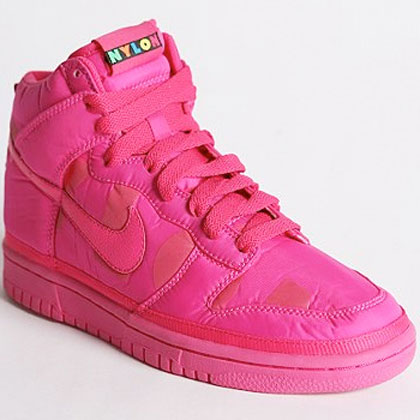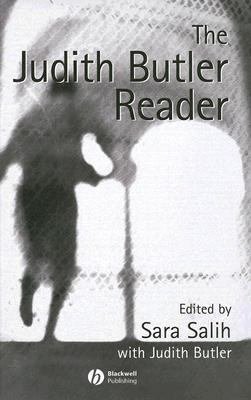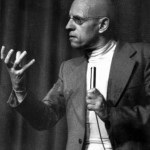It is hard to believe, but this is my 100th post. Way back in July, I wrote my 50th post. Sure, it has taken me a while to double that number, but I am still very proud of how much I have written in this blog. In the 50th post I mentioned how I had written a total of 36,301 words. Here is the word count now: 79, 418! Why does this matter? I am not totally sure…maybe it just sounds more impressive to say such a big number (am I admitting too much?)
What, you may ask, is the “chewy bagel award”? Many years ago my dad read my presentation on Judith Butler, radical democracy and identity politics that I wrote for the National Women’s Studies Association Conference. After finishing it, he remarked on how dense it was and what careful attention and concentration it demanded of the reader. On the top of the presentation he wrote, “Winner of the Chewy Bagel Award for 2004.” I think that this 100th post, which is all about Foucault, critique, Butler and virtue is worthy of the “Chewy Bagel Award for 2010” for 2 reasons. First, this post is a chewy bagel because it is dense and requires that both the writer (me) and the reader (you) devote substantial time to thinking through the claims that Foucault, Butler and I are making about critique, disobedience, troublemaking and virtue. Second, this post is a chewy bagel because it is about promoting slow and careful rumination (chewing) on ideas, words, and claims. Here is what Butler says in “What is Critique: An Essay on Foucault’s Virtue” about the need for chewiness and how it enables us to patiently and persistently think and reflect:
But here I would ask for your patience since it turns out that critique is a practice that requires a certain amount of patience in the same way that reading, according to Nietzsche, required that we act a bit more like cows than humans and learn the art of slow rumination (307).
A dense, chewy bagel cannot easily be consumed. It requires effort to be eaten. A chewy bagel text is the same way. It is not meant to be easily understood or digested. It demands that we devote some serious time and effort to engaging and processing the ideas that it presents. I love the idea of cultivating patience and persistence; it resonates with one of my own visions of troublemaking, which I wrote about way back in May.
Okay, enough build up to this 100th post. Here it is. Enjoy, or should I say, bon appetit!
A couple of days ago I wrote about how I had found a way to frame the second part of my essay on Butler, troublemaking and virtue. I plan to do a close reading of her essay, “What is Critique? An Essay on Foucault’s Virtue?” In coming up with this approach, I was particularly inspired by Butler’s aside at the end of the essay. She writes:
…I do not mean to rehabilitate Aristotle in the form of Foucault (although, I confess, that such a move intrigues me, and I mention it here to offer it as a possibility without committing myself to it at once (319).
Yes! While I am also not interested in rehabilitating Aristotle through Foucault or Butler (what would it mean to rehabilitate anyway–to return or restore?), I do see a lot of potential in thinking about troublemaking (in Butler and beyond) in relation to virtue ethics and Aristotle’s Nicomachean Ethics. Discussions of character/attitude, flourishing, the need for role models, and self-making are important for my own development of the moral significance of making and staying in trouble. I want to use this entry to work through some of the connections between Foucault, Butler, troublemaking and virtue.
So, what is the connection between Foucault and virtue? Here is an answer that I gave a few months back:
My vision of troublemaking as an ethical attitude is partly inspired by Michel Foucault and his discussion of the limit attitude in “What is Enlightenment?.” He describes this attitude, which he also calls the “critical ontology of ourselves” as “an attitude, an ethos, a philosophical life in which the critique of what we are is at one and the same time the historical analysis of the limits imposed on us and an experiment with the possibility of going beyond them” (319).
In his discussion of the critical attitude (or critique), Foucault uses the language of virtue ethics. His emphasis on attitude/ethos/philosophical life is about the quality of one’s character and how we should live and approach our actions. While my own thinking about virtue and Foucault is based on “What is Enlightenment,” virtue-speak is also very present in “What is Critique?” (a lecture from 1978 that predates his more well-known, “What is Enlightenment?”). Consider what Foucault writes about critique/critical attitude as
a certain way of thinking, speaking, and acting, a certain relationship to what exists, to what one knows, to what one does, a relationship to society, to culture and also a relationship to others (24).
And how he explicitly connects it to virtue:
There is something in critique which is akin to virtue. And in a certain way, what I wanted to speak to you about is this critical attitude as virtue in general (25).
Hmm…note how Foucault doesn’t say that the critical attitude is a virtue, but virtue in general. What does that mean? How are critique and virtue connected here? I hope to revisit this claim later. After contrasting some ways in which critique is often understood (as a judgment, way of evaluating ideas or norms, centered on fault-finding, distanced from actual practices) with how Foucault envisions it (as the suspending of judgment, only realized in concrete situations and practices, aimed at exposing the very framework of evaluating good/bad, right/wrong, productive/unproductive), Butler takes up the claim that the critical attitude is (a) virtue on page 308 (in The Judith Butler Reader). She ruminates on what Foucault means by virtue, writing:
- virtue is about an attribute or a practice of a subject OR a quality that conditions and characterizes a certain kind of action or practice (308)
- It is not only a way of complying with/conforming to norms, but a critical relation to those norms (309)
- Foucault envisions this as a stylization of morality [stylization = fashioning = self-making]
This critical relation to the norms is about not fully complying with those norms and about questioning their validity and their limits. This questioning is not meant to merely refuse or resist a norm–in the case of this essay, Foucault positions his argument in relation to the norms of governmentality/what it means to be governed, or “how not to be governed” (312). Instead, a critical relation to the norm (to being governed) is to ask after why one is governed in such a way and “how not to be governed like that, by that, in the name of those principles, with such and such an objective in mind and by means of such procedures, not like that, not for that, not by them” (Butler, 312). For Butler, raising these questions goes beyond calling out a form of being governed as invalid; it marks the limits of how governing is established and calls into question “the epistemological orderings that have established rules of governmental validity” (313). In other words, to question a rule/the rules of governmentality is to do more than find fault with that particular rule (a “traditional” role of critique); it is to question and expose how governmentality has been ordered in a particular historical/cultural moment. And it is to open up a space for critically exploring how the system of rules is ordered and how that ordering shapes who/what is governed and how. Butler writes:
To be governed is not only to have a form imposed upon one’s existence, but to be given the terms within which existence will and will not be possible (314).
Wow–this language sounds strikingly familiar to the discussion of the livable life and which lives are possible that she makes in Undoing Gender, which was written 4 years after this essay on Foucault and critique. Interestingly enough, in her more recent work (from Undoing Gender in 2004 and on), the work that is labeled as her “turn to ethics,” she doesn’t explicitly invoke Aristotle or virtue ethics. What happened? She still uses virtue ethics language, like “flourishing” or “the good/livable life,” but never theorizes them in relation to Aristotle or Aristotle through Foucault. More on that later. For now, let’s focus on Foucault and virtue as a critical relation to norms.
A critical relation to norms is not just a rejection of or a judgment against those norms. Throughout his work, Foucault discusses a number of reasons why he isn’t interested in rejection or judgment:
- Foucault doesn’t think that one can ever fully reject and be free of norms because it is through those norms that we come to exist (and be produced) as subjects; to reject those norms is to reject ourselves (which is not possible).
- He dislikes how judgment usually takes the form of polemics that discourage thought and prevent engagement with ideas and with each other.
- Finally, he is not interested in determining what is good or bad because that type of judgment shuts down action. He writes:
My point is not that everything is bad, but that everything is dangerous, which is not exactly the same as bad. If everything is dangerous, then we always have something to do. So my position leads not to apathy but to a hyper- and pessimistic activism (256, Foucault Ethics: Volume I).
So, instead of rejection or judgment, a critical relation to norms is about something else. It is about virtue as “a non-prescriptive form of inquiry” (308) that is not based on rules or on training one’s character to properly submit to rules. Foucault’s idea of virtue is about the “the art of not being governed, or, better, the art of not being governed like that and at that cost” (312). Foucault and Butler want to distance their version of virtue from obedience to rules and the idea that virtue/virtue ethics is the training of one’s character so that it properly (and effortlessly) conforms to the standard/norm of what is “good” or what leads to happiness (eudamonia). Instead, they envision the practice of virtue to be concerned with the transformation of the self into a person who not only questions the rules, but who questions their own relation to the rules and who asks: a. how have I been produced in relation to those rules? b. how do these rules determine whether my life is possible or not? and c. how might I live otherwise in relation to these rules? Here’s how Butler asks these questions:
What counts as a person? What counts as a coherent gender? What qualifies as a citizen? Whose world is legitimated as real? Who can I become in such a world where the meanings and limits of the subject are set out in advance for me? By what norms am I constrained as I begin to ask what I may become? And what happens when I begin to become that for which there is no place within the given regime of truth (314-315)
I am again struck by the close parallels between Butler’s language in this essay and her language in Undoing Gender. Undoing Gender still shows traces of virtue-speak, but there is not explicit connection made between the above questions and Foucault’s virtue. Why not?
Again, I hope to take the point about Butler and the shift from this essay on Foucault to Undoing Gender and other ethical texts (Precarious Life, Giving an Account of Oneself) later in my larger project on Butler and her “ethical turn.” For now, I want to get back to the crucial connection between a critical relation to norms (as not obeying, questioning) and virtue. The key here (and the key, I think, for my own thinking about why troublemaking is a virtue and why virtue ethics are important for envisioning projects like Butler as ethical projects) is that a critical relation to norms or being critical of authority necessarily demands the transformation of the self into one-who-doesn’t obey or one-who-questions. Butler writes: “To be critical of an authority that poses as absolute requires a critical practice that has self-transformation at its core” (311). Transforming one’s self into one who questions or who refuses to accept authority as absolute requires training that self through repeated practice (habit) of questioning and interrogation of the limits of that authority. Butler describes this repeated practice in terms of Foucault and his idea of “the art of voluntary insubordination” or the styling of the self, through the cultivation of a particular set of practices, into someone who resists and thinks otherwise. I wonder: what connections can we draw between Aristotle’s habitual practice of virtue and Butler’s notion of performativity/citationality?
Now, this sounds a lot like virtue and the forming of a virtuous self through the repeated practice of virtuous acts. Is it the same? While I don’t have a space to (this entry is already ridiculously long at 2230 words and I am not interested in making it a ridiculously ridiculously long entry) or the interest in (maybe in a future essay) outlining how virtue and habit work in Aristotle, I want to briefly mention one way that Butler (and presumably Foucault) wishes to distinguish the art of insubordination with Aristotelean habit: Foucault’s stylization of the self is not done by an autonomous self who can easily or fully reject authority or whose ability to resist can be derived from an autonomous will or some inner essence that is free of the power that she resists. The person who transforms themselves into one who resists/who questions/who doesn’t accept authority as absolute risks a lot in doing so. What do I mean by this? I confess that my patience (and I fear, yours) has run out. Chewing on an idea is great, but at a certain point your jaw gets tired–Am I taking this metaphor too far? I think I need to wrap this entry up. Before I do, here are two passages from JB that speak to my last point that I want to address in a future entry…or two…or three…or more:
In deliberating on what Foucault is suggesting about the self and their agency and intentionality in their actions, Butler writes:
Although Foucault refers quite straightforwardly to intention and deliberation in this text, he also lets us know how difficult it will be to understand this self-stylization in terms of any received understanding of intention and deliberation (321).
In concluding her essay on Foucault, Butler writes:
The self forms itself, but it forms itself within a set of formative practices that are characterized as modes of subjectivations. That the range of possible forms is delimited in advance by such modes of subjectivation does not mean that the self fails to form itself, but to form itself within forms that are already more or less in operation and underway. Or, one might say, it is compelled to form itself within practices that are more or less in place. But if that self-forming is done in disobedience to the principles by which one is formed, then virtue becomes the practice by which the self forms itself in desubjugation, which is to say that it risks its deformation as a subject, occupying that ontologically insecure position which poses the question anew: who will be a subject here, and what will count as a life, a moment of ethical questioning which requires that we break the habits of judgment in favor of a riskier practice that seeks to yield artistry from constraint (321).
Wow, I could write a whole ridiculously long entry unpacking this final statement. I love the last line about breaking habits. How might troublemaking as virtue be about breaking old habits (or breaking from habits) and forming/training new ones? What does a virtue ethics that emphasizes being un-trained instead of just being trained? Cool–now I just need another week of spring break to explore these questions. Sigh…
Word Count: 2680




